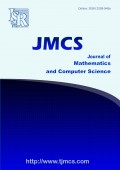Optimal control of a basic model of oncolytic virotherapy
Volume 24, Issue 2, pp 119--126
http://dx.doi.org/10.22436/jmcs.024.02.03
Publication Date: January 21, 2021
Submission Date: August 13, 2020
Revision Date: November 21, 2020
Accteptance Date: December 17, 2020
-
1409
Downloads
-
2699
Views
Authors
Abdullah Abu-Rqayiq
- Department of Mathematics \(\&\) Statistics, Texas A\(\&\)M University, Corpus Christi, Texas 78412, U.S.A..
Haneen Alayed
- Department of Mathematical Sciences, New Mexico State University, Las Cruces 88003, U.S.A..
Mohammad Zannon
- Department of Mathematics \(\&\) Statistics, Tafilah Technical University, At-Tafilah, Jordan.
Abstract
This paper applies an optimal control approach to study the dynamics of a basic Oncolytic Virotherapy model. This study applies mathematical modeling based on an established basic oncolytic virotherapy model for tumor growth. Choosing an appropriate control strategy is essential to reduce the cost of the therapy. By applying optimal control theory, we seek to minimize the cost of virotherapy and reduce the load of tumor cells. The existence of optimal control is proved. State solution given an optimal strategy and the optimal control is determined. Numerical simulation is carried out to visualize and support our results.
Share and Cite
ISRP Style
Abdullah Abu-Rqayiq, Haneen Alayed, Mohammad Zannon, Optimal control of a basic model of oncolytic virotherapy, Journal of Mathematics and Computer Science, 24 (2022), no. 2, 119--126
AMA Style
Abu-Rqayiq Abdullah, Alayed Haneen, Zannon Mohammad, Optimal control of a basic model of oncolytic virotherapy. J Math Comput SCI-JM. (2022); 24(2):119--126
Chicago/Turabian Style
Abu-Rqayiq, Abdullah, Alayed, Haneen, Zannon, Mohammad. "Optimal control of a basic model of oncolytic virotherapy." Journal of Mathematics and Computer Science, 24, no. 2 (2022): 119--126
Keywords
- Oncolytic virotherapy
- optimal control
- tumor cells
- hamiltonian
MSC
References
-
[1]
A. Abu-Rqayiq, M. Zannon, On Dynamics of Fractional Order Oncolytic Virotherapy Models, J. Math. Computer Sci., 20 (2020), 79--87
-
[2]
Z. Bajzer, T. Carr, K. Josic, S. J. Russell, D. Dingli, Modeling of cancer virotherapy with recombinant measles viruses, J. Theoret. Biol., 252 (2008), 109--122
-
[3]
W. H. Fleming, R. W. Rishel, Deterministic and Stochastic Optimal Control, Springer Verlag, New York (1975)
-
[4]
A. Friedman, J. P. Tian, G. Fulci, E. A. Chiocca, J. Wang, Glioma Virotherapy: Effect of Innate Immune Suppression and Increased Viral Replication Capacity, Cancer Res., 66 (2006), 2314--2319
-
[5]
N. L. Komarova, D. Wodarz, ODE models for oncolytic virus dynamics, J. Theoret. Biol., 263 (2010), 530--543
-
[6]
R. M. Neilan, S. Lenhart, An Introduction to Optimal Control with an Application in Disease Modeling, DIMACS Ser. Discrete Math. Theoret. Comput. Sci., 75 (2010), 67--81
-
[7]
A. S. Novozhilov, F. S. Berezovskaya, E. V. Koonin, G. P. Karev, Mathematical modeling of tumor therapy with oncolytic viruses: regimes with complete tumor elimination within the framework of deterministic models, Biol. Direct, 6 (2006), 1--18
-
[8]
J. P. Tian, The Replicability of Oncolytic Virus: Defining Conditions in Tumor Virotherapy, Math. Biosci. Eng., 8 (2011), 841--860
-
[9]
L. M. Wein, J. T. Wu, D. H. Kirn, Validation and analysis of a mathematical model of a replication-competent oncolytic virus for cancer treatment: Implications for virus design and delivery, Cancer Res., 63 (2003), 1317--1324
-
[10]
D. Wodarz, Viruses as antitumor weapons: defining conditions for tumor remission, Cancer Res., 61 (2001), 3501--3507
-
[11]
D. Wodarz, Computational approaches to study oncolytic virutherapy: insights and challenges, Gene Ther Mol Biol, 8 (2004), 137--146
-
[12]
J. T. Wu, H. M. Byrne, D. H. Kirn, L. M. Wein, Modeling and analysis of a virus that replicates selectively in tumor cells, Bull. Math. Biol., 63 (2001), 731--768

